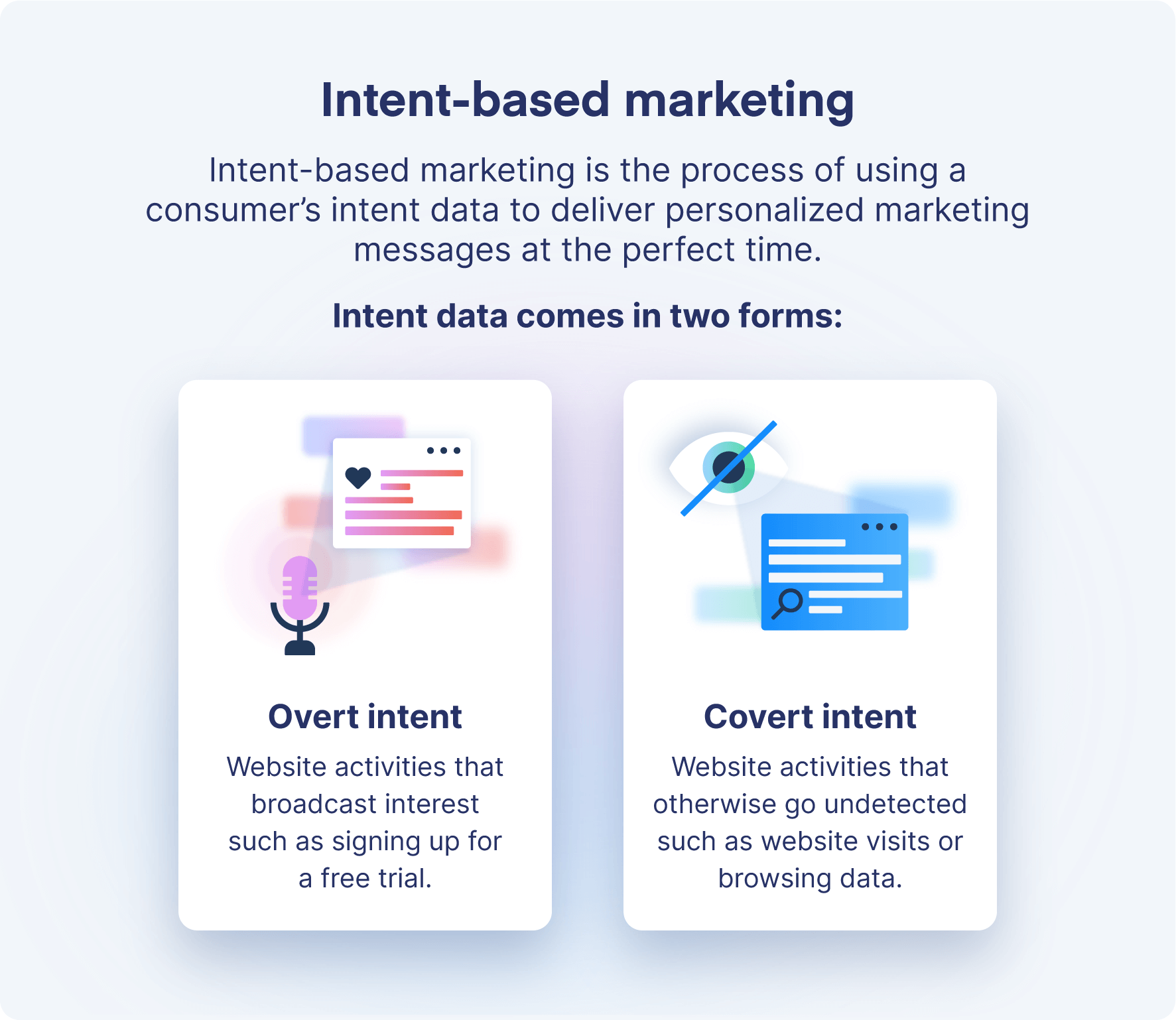Intent-based marketing: How to target better B2B leads for your business
Wouldn’t it be easier to focus your marketing efforts on warm leads—primarily spending time and resources on interested prospects? With intent-based marketing, you can.
Intent-based marketing is a way for businesses to increase the effectiveness of their outreach efforts without increasing their budget. Using customer intent data, companies can deliver personalized, relevant messaging to the right prospects at the right time.
In this article, we will detail intent-based marketing from methodology to proper execution. We’ll dive into the importance of this strategy and how you can utilize tools—like what we offer at Clearbit—to accelerate your pipeline generation efforts.
What is intent-based marketing?
Intent-based marketing is the process of using a consumer’s online activity to deliver personalized marketing messages at the perfect time. Rather than cold outreach, which involves contacting prospects that may be completely unfamiliar with your business, this method targets prospects that are known to be interested.
The driving force behind intent-based marketing is intent data, which can be used by a business to determine what products or services their potential customers are researching, web pages they’re visiting, and other behaviors associated with buying decisions.
From there, organizations can identify warm leads and focus their marketing budget on prospects who are more likely to convert.
To paint the picture, let’s say Sally is an executive at a B2B company that is looking for a new CRM tool. Through her research, she finds XYZ company and visits their product features web page multiple times. XYZ company can use intent data to identify Sally as a warm lead and focus its marketing efforts to try to win her business.
Isn’t that easier than cold outreach?
In our playbook for intent-based outreach, we identify two types of consumer intent that form a pillar of intent-based marketing: overt intent and covert intent.
Overt intent
Overt intent has been the basis of marketing efforts for years. This type of intent is when a consumer actively fills out a form or participates on a business’s website in some way. A few common examples include:
- Downloading a whitepaper
- Submitting contact information
- Signing up for a demo or webinar
- Signing up for a free trial
The problem with overt intent is that the vast majority of website visitors don’t complete these actions. Maybe they are interested but need to coordinate with other members of their team, feel they need to learn more, or simply get distracted. This results in a massive pool of potential customers who go unnoticed by a business—which is where covert intent comes in.
Covert intent
Covert intent is the basis of a successful intent-based marketing approach—and something we are experts at uncovering here at Clearbit.
This type of intent focuses on the meaningful actions of website visitors that might go unnoticed without an intent-based marketing strategy or tool. Some examples of this type of consumer intent include:
- Multiple website visits over the course of a few days
- Visits to product/pricing pages
- Visiting your product implementation docs or help center
- Researching competitors on review sites
It’s easy to see that this type of data can make a huge difference in a business’s marketing strategy, which is why it’s so important to gather covert intent to supplement outreach efforts.

Where does intent data come from?
Consumer intent data can be gathered from two primary sources: internal and external.
Internal sources
Internal data can be amassed from any consumer action that a business can directly track. This involves anything from their own channels such as:
- Website or app data
- Directly submitted contact data (website forms, downloadables, free trials, etc.)
- Paid ad data (clicks, impressions, etc.)
This information is important, but it doesn’t paint the full picture of a potential customer’s business needs.
External sources
External consumer intent data can be gathered from third-party sources to gain a larger understanding of website visitors. Using cookies and other forms of tracking methods, third-party companies can gather insight into what consumers are doing when they aren’t directly interacting with a business.
Some of these insights include:
- Consumer location
- Engagement
- Bounce rate and time spent on websites
- Frequent searches for products, alternative solutions, or competitors
Using both internal and external sources of information can help a business compile a deeper understanding of potential customers, so it can send them marketing messages at the right time.
4 benefits of intent-based marketing
Properly implementing intent-based marketing can help a business do more with less, making a difference in four key ways.
1. Stretch your advertising budget
Traditional marketing often involves casting a wide, calculated net in an effort to reach interested customers. However, this has the potential to consistently miss the mark, wasting time and resources on marketing campaigns that aren’t quite effective enough.
With intent-based marketing, your efforts will be laser-focused on potential customers who are actively searching for the products or services your business offers. This allows a company to optimize its advertising budget, turning prospects into customers more effectively.
2. Discover new prospects
When businesses use intent data to monitor their website visitors, they can uncover brand-new prospects that were not previously being targeted.
Marketers may use information such as market research and insights from a current customer base to develop a consumer profile or target market for their business. However, a large portion of this data relies on overt intent—the customers who are actively participating in purchasing, downloading, or submitting information.
Intent-based marketing flips that methodology on its head.
When businesses gather data on covert visitors—those who browse without completing an action—they can develop an expanded consumer profile. Once an intent-based marketing system is put in place, businesses can use browsing data to expand their outreach into new frontiers, reaching previously untapped yet interested consumers.
3. Gather higher-quality leads
Intent-based marketing can deliver a wealth of warm leads, which have enhanced information for sales and marketing departments to capitalize on.
When monitoring website visitors with this method, an organization will receive a comprehensive profile of potential customers that includes valuable information, such as:
- Name of the prospect
- What company they work for
- Size of the company
- Their position (e.g., director, executive)
- What website pages they have visited and how frequently
When it comes to turning visitors into customers, the more information a sales team has to work with, the better—and the difference in consumer information between traditional marketing methods and an intent-based approach is like night and day.
4. Enhance the consumer experience
Consumers respond more positively to personalization.
In fact, a study from Epsilon found that four out of five consumers are more likely to buy when businesses deliver personalized information. Intent-based marketing allows organizations to monitor where potential customers are virtually visiting, affording the opportunity for personalized messaging.
A few examples include:
- Sending an email to a prospective customer who has visited a product page multiple times but has not made a purchase yet
- Using targeted social media ads to reach out to customers based on their browsing history
- Reaching out to schedule a meeting with a prospective client who has visited your website frequently
The more personalized and timely a business can make its messaging, the more effective it will be.

How to implement intent-based marketing
Now that we’ve highlighted the advantages of intent-based marketing, here’s how you can implement it in your own operations.
1. Clearly define an ideal customer profile
To succeed with intent-based marketing, you first need to define an ideal customer profile (ICP).
An ICP is a profile of the perfect customer for your business. To narrow down what that might look like, analyze a few key data points to guide your organizational decision-making:
- Establish success criteria for your business: Clearly define what is important to your organization for the near future. Are you looking for new business? Do you want to cultivate long-term customers? Maybe explore opportunities for cross-selling and promotion? The more specific your success criteria are, the easier defining an ICP will be.
- Analyze previous customers: Look at previous or current customers who meet your newly established success criteria. Who are they? What are their buying habits? If in a B2B industry, who do they work for? How large is the company? Be as specific as possible.
Once you’ve established a clear ICP, your organization can move forward with an intent-based marketing approach.
2. Gather intent-based data
Next, it’s important to gather intent-based data—and the easiest way is to work with a tool that helps you to identify and capture website visitors showing intent like Clearbit Capture.
Clearbit can reveal high-intent website traffic to determine who is visiting your site, what companies they represent, and a host of other helpful data points. In combination with your ICP, you can use this information to start a personalized dialogue with these prospects, turning them into customers more effectively.
3. Develop personalized content
At this stage, you’ve established an ICP and gathered intent-based data, and now it’s time to send personalized content to potential customers. Personalization is very important for a brand, and in fact, 77% of B2B sales and marketing executives agree that personalized marketing improves customer relationships.
This type of curated messaging can include tactics such as personalized emails, advertising campaigns, and even direct phone calls if appropriate. To be as efficient as possible, you should segment your audiences into subsections—we recommend 7 golden audiences.
From here, your organization will have a playbook for what to do in predetermined situations. For example, if an assigned account has been consistently visiting a specific section of your website or if an unassigned account has been visiting the pricing page frequently, your business will know how to respond without deliberation.
4. Continuously test and optimize
Once the above has been established, it’s important to continuously test, optimize, and iterate to maintain peak efficiency.
No matter what industry you’re in, both the marketplace and consumer preferences can change rapidly. It’s a good idea to revisit outreach methods periodically—potentially performing A/B testing along the way—to make sure your operations and customer acquisition methods are as effective as possible.
Partner with a leader in intent-based marketing
Intent-based marketing is a way for businesses to double their pipeline without doubling their budget. That being said, it can be tough to develop this new strategy alone. At Clearbit, we are experts in everything intent-based marketing, and can be the partner you need to accelerate your pipegen efforts.


